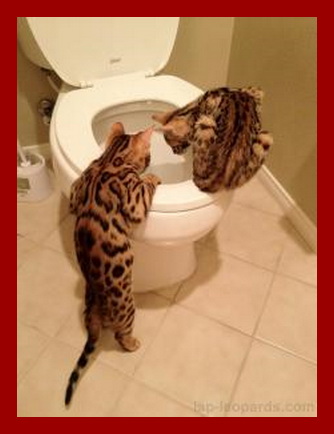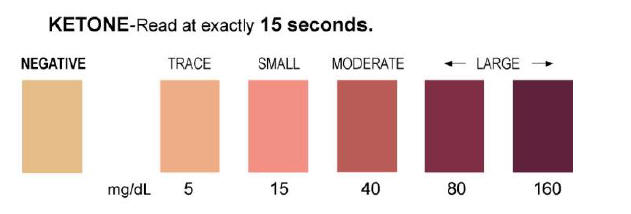The information contained in this sticky is provided for educational purposes only and is not intended to replace veterinary advice. The intention of this sticky is to open doors to understanding about the specific medical condition or topic, allowing for educated and on-going discussion with your vet.
 |
Diabetic Cat Care
Ketones 101
When and How to Check for Them |
Many of us have heard of ketogenic diets; used often by bodybuilders, or to help with weight loss. The science is that by keeping the body in a ketone producing state, fat stores will be used by the body, weight will drop off much more quickly. That may be fine for humans, but producing ketones is the last state we want our diabetic cats to be in.
Ketones
occur when the body cannot access blood glucose for energy. Left
untreated, ketones build up in
the system and can lead to a life threatening situation
called
Diabetic
Ketoacidosis,
also known as DKA.
While development of ketones is not an "immediate emergency",
the progression of excessive ketones which
develop into diabetic ketoacidosis IS a very real
emergency situation
requiring
immediate veterinary
care and very aggressive treatment.
Ketones are a direct result of hyperglycemia (high BG). Ketones can develop because of not enough insulin, illness, infection, and/or anorexia. In humans, ketones can be produced when the body burns too much fat storage for energy.
While
practicing TR it is very rare for a cat to produce ketones once the BG is well
regulated. That said, at the start of TR, right after diagnosis, if your
cat is sick, or when making an insulin switch, its strongly recommended
as a precaution
to test for ketones if your cat is over renal threshold (225/12.5)
for longer than a day. For those cats prone to quick ketone production, checking
for ketones after only two or three tests resulting in higher numbers might recommended.
Typically on TR, because the protocol is far more aggressive than traditional
treatment methods, regularly testing for ketones isn't required.
What are ketones?
Normally,
cells get the energy that they need to function by using blood glucose.
Insulin plays a vital role in the process: it is the key that unlocks the
receptors on cells, letting them access this essential fuel.
Because it
can’t find its usual source of energy, the body turns to the next available
energy source and starts burning up muscle and fat.
The liver responds to the situation by secreting ketones and
glycogen (pushing glucose levels higher in the process).
When the level of
ketones becomes
too high to be
utilized by the system, ketones
start building up in the blood stream.
When should you
check for ketones?
Some cats
are more sensitive to developing ketones than others,
and will show ketones at lower levels and in a shorter
period of time; others need to be in
consistently higher numbers for longer
periods… and some just seem to be immune to
developing ketones.
ECID.
How
to
check for ketones?
Checking for
ketones can either be done via urine strips or certain glucometers will also
test for blood ketones (such as the
Nova Max Plus). The test strips for meters are
about double the cost of urine test strips. Ketone testing at home is a
lot less expensive than the
To use the urine
strips, its best to insert the
stick under the urine stream as your cat is urinating – this can take
some practice! Some people have had success putting a ladle or long
handled spoon under the cat as it is having a pee. Some
cats (particularly males) if taken for a walk outside will gladly take a pee
while marking their territory! Alternatively, pressing
the strip into the pool of urine in the litter
immediately after your cat has urinated,
before the urine is absorbed by the litter, also works. It can help
to put a minimal amount of litter in the box so that
you have a pool of urine to dip the strip into.
Fresh urine is required to have accurate results when checking for ketones. If using Keto-Diastix, once dipped in urine, it is very important to count off 15 seconds only, then immediately match the ketone test strip to the chart on the side of the bottle. If left too long before matching to the bottle, the ketone test strip will change to the darkest color, giving a false result.

I have a positive
ketone reading....what do I do now????
Please post on Talking
TR asap so
experienced members
can review your cat's situation with you and
help you decide what is the best course of
action
based on your cat's
individual
circumstances.
Trace and low
level ketones may be possible for you to handle
at home without vet
intervention depending on the following
circumstances:
If your cat is
showing medium or higher level ketones and/or
is showing any of the following symptoms, these
are symptoms of DKA which is life threatening. This means without a doubt,
the situation has become a medical
emergency requiring immediate intervention by
your vet:
If you have any
questions about ketones or DKA, or if you have tested for ketones at home and the
results are positive - even at a low (trace) level -
please post on Talking TR for
for immediate assistance.
Does a low-carb
diet increase the risk of ketones?
Po
It is helpful to understand the whys and whens of ketones (or ketone bodies as they are sometimes called) in order to understand the answer to this (these) questions. In the animals with which we are most familiar (including people and cats), the brain's preferred fuel source is glucose. Skeletal muscle and other tissues are pretty happy using fat (triglycerides) for energy, but the brain is characteristically picky about this (and it's generally wise to give the brain what it wants!). One of insulin's chief jobs is to make sure that circulating glucose gets into the brain on demand; insulin is the molecule that "drives" glucose across the cell membrane.
When insulin is in short supply or absent, the body (and the brain) perceive that there is a shortage of glucose (even if there really isn't, as when the animal is hyperglycemic), and the brain's second and final fuel source begins to be produced, ketones. Ketones are produced by the liver from the oxidation of the body's fat stores. In conditions of true starvation (when body fat is legitimately broken down for necessary calories), or perceived starvation (hyperglycemic, uncontrolled diabetes), the liver believes it needs to produce ketones from body fat for the brain. This is the reason you see ketones in the urine of unregulated feline diabetics. You see ketosis in humans on some of the more strict high protein, low carb diets, because there is little dietary carbohydrate to supply glucose from the GI tract, and the human body is not as efficient at gluconeogenesis (liver production of glucose from protein) as the cat (we have discussed this very major difference between cats and most other mammals on the board in the past). Because gluconeogenesis in people cannot keep up with the brain's needs under these circumstances, the liver makes up the shortfall with ketone body production. Except in extreme prolonged ketosis, this is not harmful to the normal human. After all, it is a normal survival mechanism. Naturally, it is not good to have severe metabolic acidosis (ketones cause the body to become relatively acid) for too prolonged a period (many weeks) because it can deplete body stores of buffers (mineral, generally). In starvation, however, it certainly beats the alternative (rapid brain death).
This brings us to the question of whether a low carb, high protein diet is bad for a diabetic cat, and does it cause ketosis? If you've been following this discussion so far, you are probably ready to guess that no, such diets do not cause ketosis in cats, diabetic or normal. In diabetic cats on high carb diets (especially dry, extruded commercial cat foods where the dietary glucose is rapidly absorbed into the bloodstream from the gastrointestinal tract), the cat's brain nonetheless perceives "starvation" and ketones from the liver catabolism of fat begin circulating (and spilling into the urine, right along with the excess dietary glucose). This chronic circulating glucose has a suppressive effect on the cat's pancreas (mechanism unknown at this point), not to mention all of the other undesirable effects of chronic, poorly regulated diabetes. Most, if not all, commercial preparations of exogenous insulin work poorly in the cat (I don't have to tell all of you that!), so the hyperglycemia is essentially constant in most diabetic cats on high carb diets.
When the cat eats a low carb, high protein diet, however, little preformed glucose enters the blood stream. The liver produces what glucose the brain needs in a much more moderate, "time-released" fashion through gluconeogenic transformation of dietary protein, the pancreas-suppressive effects of hyperglycemia is significantly lessened (and in many cats, endogenous production of insulin resumes) and the body of the cat perceives a much more normal process of glucose production and uptake that satisfies the brain's needs.
We have not seen ketosis in cats on low carb, high protein diets. This is the normal diet of the cat and its metabolic machinery is especially adapted to such a diet as the normal order of things, in times of feast as well as famine.